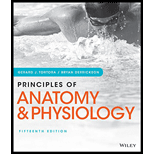
Principles of Anatomy and Physiology
15th Edition
ISBN: 9781119329398
Author: Gerard J Tortora, Bryan Derrickson
Publisher: John Wiley & Sons Inc
expand_more
expand_more
format_list_bulleted
Concept explainers
Question
Chapter 2, Problem 17CP
Summary Introduction
To review:
The precise definition of isomers.
Introduction:
Atoms are the basic structural constituent of all matter. These atoms may exist as individual entities called elements or they may exist as bonded frameworks called compounds. All compounds have distinct structural, physical, and chemical properties because of the different molecular formulas. However, some compounds may have a similar molecular formula but still, differ in chemical properties.
Expert Solution & Answer
Want to see the full answer?
Check out a sample textbook solution
Students have asked these similar questions
Briefly state the physical meaning of the electrocapillary equation (Lippman equation).
Explain in a small summary how:
What genetic information can be obtained from a Punnet square? What genetic information cannot be determined from a Punnet square?
Why might a Punnet Square be beneficial to understanding genetics/inheritance?
In a small summary write down:
Chapter 2 Solutions
Principles of Anatomy and Physiology
Ch. 2 - List the names and chemical symbols of the 12 most...Ch. 2 - What are the atomic number, mass number, and...Ch. 2 - Define isotopes and free radicals.Ch. 2 - Which electron shell is the valence shell of an...Ch. 2 - Compare the properties of ionic, covalent, and...Ch. 2 - What information is conveyed when you write the...Ch. 2 - Checkpoint 7:
What is the relationship between...Ch. 2 - Compare potential energy and kinetic energy.Ch. 2 - Checkpoint 9:
How do catalysts affect activation...Ch. 2 - How are anabolism and catabolism related to...
Ch. 2 - Why are oxidation–reduction reactions important?Ch. 2 - Checkpoint 12:
How do inorganic compounds differ...Ch. 2 - Describe two ways to express the concentration of...Ch. 2 - Prob. 14CPCh. 2 - Checkpoint 15:
How do bicarbonate ions prevent...Ch. 2 - Prob. 16CPCh. 2 - Prob. 17CPCh. 2 - How are carbohydrates classified?Ch. 2 - Prob. 19CPCh. 2 - Prob. 20CPCh. 2 - Checkpoint 21:
Distinguish among saturated,...Ch. 2 - Define a protein. What is a peptide bond?Ch. 2 - What are the different levels of structural...Ch. 2 - Why are enzymes important?Ch. 2 - Checkpoint 25:
How do DNA and RNA differ?
Ch. 2 - Prob. 26CPCh. 2 - In the reaction catalysed by ATP synthase, what...Ch. 2 - CTQ 1: Your best friend has decided to begin...Ch. 2 - CTQ 2:
A 4-month-old baby is admitted to the...Ch. 2 - CTQ 3:
During chemistry lab, Maria places sucrose...
Knowledge Booster
Learn more about
Need a deep-dive on the concept behind this application? Look no further. Learn more about this topic, biology and related others by exploring similar questions and additional content below.Similar questions
- Not part of a graded assignment, from a past midtermarrow_forwardNoggin mutation: The mouse, one of the phenotypic consequences of Noggin mutationis mispatterning of the spinal cord, in the posterior region of the mouse embryo, suchthat in the hindlimb region the more ventral fates are lost, and the dorsal Pax3 domain isexpanded. (this experiment is not in the lectures).a. Hypothesis for why: What would be your hypothesis for why the ventral fatesare lost and dorsal fates expanded? Include in your answer the words notochord,BMP, SHH and either (or both of) surface ectoderm or lateral plate mesodermarrow_forwardNot part of a graded assignment, from a past midtermarrow_forward
- Explain in a flowcharts organazing the words down below: genetics Chromosomes Inheritance DNA & Genes Mutations Proteinsarrow_forwardplease helparrow_forwardWhat does the heavy dark line along collecting duct tell us about water reabsorption in this individual at this time? What does the heavy dark line along collecting duct tell us about ADH secretion in this individual at this time?arrow_forward
arrow_back_ios
SEE MORE QUESTIONS
arrow_forward_ios
Recommended textbooks for you
 Biology (MindTap Course List)BiologyISBN:9781337392938Author:Eldra Solomon, Charles Martin, Diana W. Martin, Linda R. BergPublisher:Cengage Learning
Biology (MindTap Course List)BiologyISBN:9781337392938Author:Eldra Solomon, Charles Martin, Diana W. Martin, Linda R. BergPublisher:Cengage Learning Biology: The Dynamic Science (MindTap Course List)BiologyISBN:9781305389892Author:Peter J. Russell, Paul E. Hertz, Beverly McMillanPublisher:Cengage Learning
Biology: The Dynamic Science (MindTap Course List)BiologyISBN:9781305389892Author:Peter J. Russell, Paul E. Hertz, Beverly McMillanPublisher:Cengage Learning Principles Of Radiographic Imaging: An Art And A ...Health & NutritionISBN:9781337711067Author:Richard R. Carlton, Arlene M. Adler, Vesna BalacPublisher:Cengage Learning
Principles Of Radiographic Imaging: An Art And A ...Health & NutritionISBN:9781337711067Author:Richard R. Carlton, Arlene M. Adler, Vesna BalacPublisher:Cengage Learning Human Heredity: Principles and Issues (MindTap Co...BiologyISBN:9781305251052Author:Michael CummingsPublisher:Cengage Learning
Human Heredity: Principles and Issues (MindTap Co...BiologyISBN:9781305251052Author:Michael CummingsPublisher:Cengage Learning Biology Today and Tomorrow without Physiology (Mi...BiologyISBN:9781305117396Author:Cecie Starr, Christine Evers, Lisa StarrPublisher:Cengage Learning
Biology Today and Tomorrow without Physiology (Mi...BiologyISBN:9781305117396Author:Cecie Starr, Christine Evers, Lisa StarrPublisher:Cengage Learning

Biology (MindTap Course List)
Biology
ISBN:9781337392938
Author:Eldra Solomon, Charles Martin, Diana W. Martin, Linda R. Berg
Publisher:Cengage Learning

Biology: The Dynamic Science (MindTap Course List)
Biology
ISBN:9781305389892
Author:Peter J. Russell, Paul E. Hertz, Beverly McMillan
Publisher:Cengage Learning

Principles Of Radiographic Imaging: An Art And A ...
Health & Nutrition
ISBN:9781337711067
Author:Richard R. Carlton, Arlene M. Adler, Vesna Balac
Publisher:Cengage Learning

Human Heredity: Principles and Issues (MindTap Co...
Biology
ISBN:9781305251052
Author:Michael Cummings
Publisher:Cengage Learning


Biology Today and Tomorrow without Physiology (Mi...
Biology
ISBN:9781305117396
Author:Cecie Starr, Christine Evers, Lisa Starr
Publisher:Cengage Learning
Macromolecules | Classes and Functions; Author: 2 Minute Classroom;https://www.youtube.com/watch?v=V5hhrDFo8Vk;License: Standard youtube license